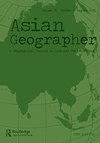东北亚的边界和扩展
IF 2.2
Q2 GEOGRAPHY
引用次数: 1
摘要
摘要本文运用跨学科的边界研究视角来解释东北亚区域一体化的缺失。虽然在世界其他地区,如欧洲或东南亚,冷战的结束和跨境联系的增加促进了一体化机构和想象中的区域社区的出现,但这种情况并未发生在东北亚。尽管该地区在冷战结束后经历了真正的跨境活动爆发,但经济和移民流动对国家间关系的潜在有益影响并没有导致建立区域机构的类似成功。本文所关注的中心问题是理解在这种明显缺乏区域一体化的情况下边界的作用。本文对东北亚边界采取了多元视角,将其视为存在于国家之间的制度、交换和流动的过程,并将其视为一个以国家和地区边界在功能和空间上广泛争论为特征的边界空间。边界研究使我们能够从东北亚地区的组成国家和地区本身的边缘分析东北亚地区,从而提供了一个多层的镜头,通过它来检查这个空间。这里进行的历史和比较分析揭示了区域发展的动态和区域运行的制约因素。本文认为,东北亚地区今天未能整合的原因在于尖锐的、证券化的内部边界和不确定的外部边界之间的对比。本文章由计算机程序翻译,如有差异,请以英文原文为准。
Bordering and scaling Northeast Asia
ABSTRACT This article utilizes an interdisciplinary border studies perspective in order to explain the absence of regional integration in Northeast Asia. While in other parts of the world, such as Europe or Southeast Asia, the cessation of the Cold War and increasing cross-border linkages promoted the emergence of integrative institutions and imagined regional communities, this has not occurred in Northeast Asia. Although the region experienced a veritable explosion of cross-border activity in the aftermath of the Cold War, potentially beneficial effects of economic and migratory flows for inter-state relations have not led to comparable success constructing regional institutions. The central issue with which the article is concerned is to understand the role of borders in this marked absence of regional integration. The paper adopts a pluralistic perspective on Northeast Asia’s borders that considers them as institutions existing between states, processes of exchange and mobility over them, and as constituting the region as a borderland space characterized by functionally and spatially extensive contestation over state and regional boundaries. Border studies allow us to analyze the Northeast Asian region from the edges of both its constituent states and the region itself, and thus offers a multi-layered lens through which to examine this space. The historical and comparative analysis conducted here reveals the dynamics of regional development and constraints under which the region operates. The paper suggests that the contrast between the Northeast Asia’s sharp, securitized, internal borders, multiplying into novel spaces, and its undetermined outer ones accounts for the failure to integrate today.
求助全文
通过发布文献求助,成功后即可免费获取论文全文。
去求助
来源期刊

Asian Geographer
GEOGRAPHY-
CiteScore
3.30
自引率
0.00%
发文量
7
期刊介绍:
Asian Geographer disseminates knowledge about geographical problems and issues focusing on Asia and the Pacific Rim. Papers dealing with other regions should have a linkage to Asia and the Pacific Rim. Original and timely articles dealing with any field of physical or human geographical inquiries and methodologies will be considered for publication. We welcome, for example, submissions on people-environment interactions, urban and regional development, transport and large infrastructure, migration, natural disasters and their management, environment and energy issues. While the focus of the journal is placed on original research articles, review papers as well as viewpoints and research notes under the category of “Asian Geography in Brief” are also considered. Review papers should critically and constructively analyse the current state of understanding on geographical and planning topics in Asia. The ‘Asian Geography in Brief’ section welcomes submissions of applied geographical and planning research about Asia. The section aims to showcase (1) the diverse geography and planning of Asia; and (2) the diverse geographical and planning research about Asia. The journal will also publish special issues on particular themes or areas. Book reviews can be included from time to time.
 求助内容:
求助内容: 应助结果提醒方式:
应助结果提醒方式:


